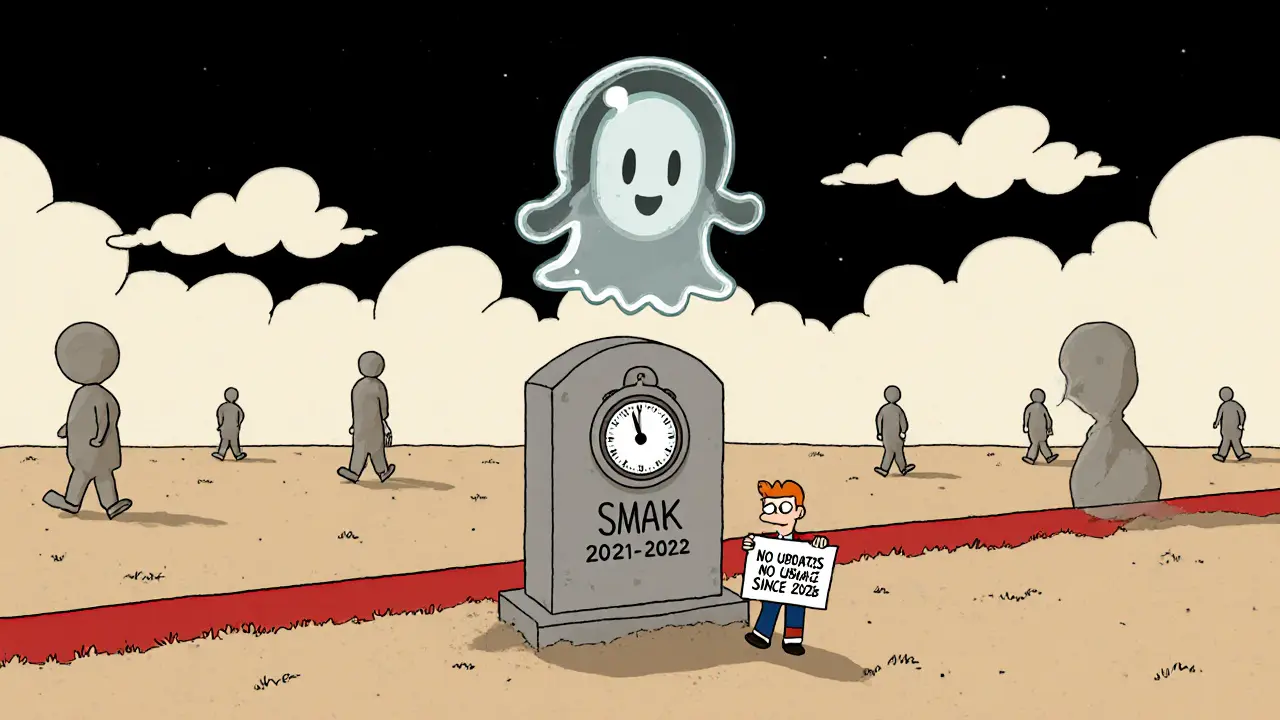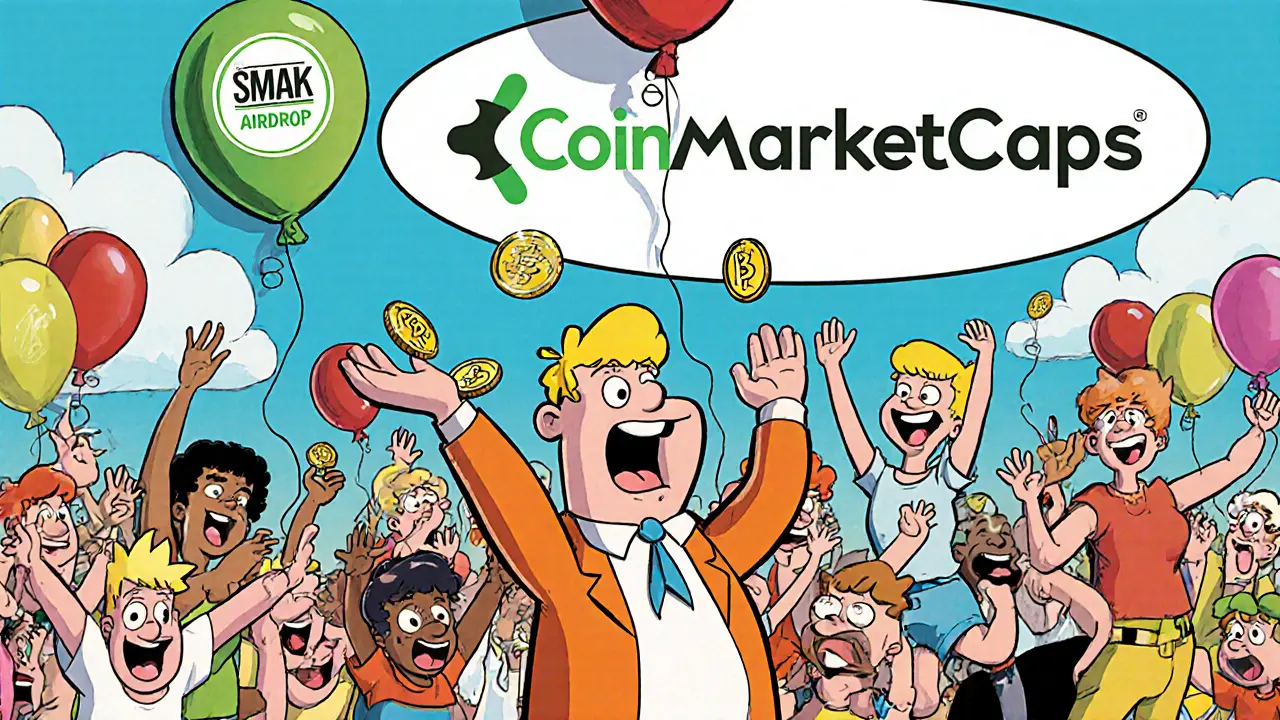Airdrop Risk Assessment Tool
Based on the lessons from the SMAK airdrop failure, this tool helps you assess the potential risk of any crypto airdrop. The SMAK project had key failure points: no real users, poor liquidity, and team silence. Use this calculator to identify if a new airdrop might face similar pitfalls.
Enter your assessment and click Calculate Risk to see the result.
The SMAK airdrop on CoinMarketCap in September 2021 looked like a solid opportunity. $20,000 in free tokens, distributed through one of the most trusted crypto data sites, with a clear timeline and official promotion. Thousands signed up. But today, SMAK trades at $0.00012 - down over 94% from its peak just a year after the airdrop. Trading volume? Zero. What went wrong?
What Was the SMAK Airdrop?
The SMAK X CoinMarketCap airdrop ran from September 13 to September 23, 2021. Smartlink, a new project building a decentralized escrow service on the Tezos blockchain, offered $20,000 worth of SMAK tokens to CoinMarketCap users who completed simple tasks: follow their social channels, verify their email, and join their Telegram group. No deposit. No purchase. Just sign up and wait. It wasn’t a gimmick. CoinMarketCap had a reputation for vetting airdrops. Users trusted it. Smartlink’s pitch was simple: SMAK was the utility token for a Web 3.0 escrow platform that could protect buyers and sellers in peer-to-peer crypto transactions. Think of it like PayPal escrow, but without a company in the middle. You lock funds in a smart contract. The seller delivers. The buyer confirms. Then the money releases. No chargebacks. No disputes. Just code. The idea made sense. Web 3.0 needed trustless intermediaries. Tezos was chosen because it was energy-efficient, fast, and had low fees - perfect for small, frequent transactions. The team even built out a full ecosystem: Smartlink Payment Processing, a decentralized marketplace, and milestone-based payment tools. It wasn’t just a token. It was a platform.Why Did People Join?
In 2021, airdrops were everywhere. People weren’t just chasing free money - they were chasing early access. If you got in early on a project like Uniswap or Polygon, you could see returns of 10x, 50x, even 100x. The SMAK airdrop felt like one of those moments. The team posted YouTube videos. They pushed updates on Twitter. CoinMarketCap listed it prominently. Thousands of users participated, hoping they’d caught the next big thing. The token distribution was straightforward. Eligible participants received a fixed amount of SMAK based on how many tasks they completed. The total supply was set at 1 billion tokens. Around 305 million were listed as circulating on CoinMarketCap after the airdrop. But here’s the first red flag: other sources claimed the circulating supply was zero. That contradiction never got resolved. Was the data wrong? Was the team hiding something? Either way, it planted doubt.What Was the Token Supposed to Do?
SMAK wasn’t meant to be a speculation coin. It had real utility inside the Smartlink ecosystem:- Escrow fee discounts - Holders paid lower fees when using the escrow service.
- Escrow rewards - Users earned SMAK for locking funds in escrow agreements.
- Governance rights - Token holders could vote on platform upgrades and fee structures.
- Payment processing - SMAK could be used as a settlement currency in the decentralized marketplace.

Why Did It Crash?
Three things killed SMAK’s momentum. 1. No real users. The airdrop brought in token holders, not users. People took the free tokens and sold them. They didn’t use the escrow service. They didn’t list products. They didn’t make payments. The platform had no traction. Without usage, the token had no reason to hold value. 2. Poor liquidity. SMAK only listed on a handful of small exchanges, mostly Gate.io. No major exchange picked it up. Without liquidity, traders couldn’t buy or sell easily. Without trading volume, price stability was impossible. The 24-hour volume is now $0. That’s not a glitch - it’s a tombstone. 3. No updates. After the airdrop, the project went quiet. No major product launches. No partnerships. No marketing. The website still exists, but the last blog update was in 2022. The team stopped responding to community questions. When a project stops communicating, the community assumes it’s dead. And in crypto, perception is reality. The price dropped from $0.0024 in late 2022 to $0.00012 today. That’s not market correction. That’s abandonment.What’s the Current State of Smartlink?
As of November 2025, Smartlink’s ecosystem is effectively inactive. The decentralized marketplace is empty. The payment gateway doesn’t process transactions. The escrow service is unreachable. The team hasn’t released a roadmap since 2022. The Tezos blockchain still runs - it’s stable, secure, and growing - but Smartlink isn’t using it anymore. The token still shows up on CoinMarketCap and CoinGecko, but the data is outdated. The circulating supply numbers conflict. The price chart looks like a flat line with occasional spikes - likely from bots or wash trading. No one’s buying. No one’s selling. It’s a ghost token.
What Can You Learn From SMAK?
The SMAK airdrop is a textbook case of how not to build a crypto project. Don’t confuse airdrop participants with users. Getting 10,000 people to claim free tokens doesn’t mean you have 10,000 users. Real adoption requires solving a real problem - and making it easy to use. Don’t launch a token without a working product. Smartlink had a whitepaper, a website, and a pitch. But they didn’t have a live, tested platform. No one could use it. No one could trust it. Tokens without utility are just digital receipts. Don’t go silent after the hype. Crypto moves fast. If you stop talking, you disappear. The community expects updates, even if they’re bad news. Silence = death. Don’t rely on a single airdrop for survival. Airdrops are a spark, not fuel. You need marketing, product development, customer support, and community engagement to keep the fire going. SMAK had the spark. It ran out of fuel.Is SMAK Still Tradable?
Technically, yes. You can still find SMAK on Gate.io and a few obscure decentralized exchanges. But you won’t find buyers. The bid-ask spread is massive. If you try to sell, you’ll likely get pennies on the dollar - if you get anything at all. If you held SMAK from the airdrop, you still have the tokens. But they’re worth less than a coffee. There’s no recovery plan. No team announcement. No roadmap. The project is over.Final Thoughts
The SMAK X CoinMarketCap airdrop was a well-executed marketing campaign. It achieved its goal: exposure. But exposure without execution is meaningless. Smartlink had a good idea, built on a solid blockchain, and attracted attention. But they never built a product people wanted to use. Crypto isn’t about hype. It’s about utility. It’s about trust. It’s about keeping your word. SMAK failed because it promised a future that never arrived. If you’re considering an airdrop now - whether you’re giving or receiving - remember this: free tokens are tempting. But the real value isn’t in claiming them. It’s in what happens after.Was the SMAK airdrop real?
Yes, the SMAK airdrop was real. It was officially hosted on CoinMarketCap from September 13 to September 23, 2021. Participants received SMAK tokens after completing basic tasks like following social accounts and verifying their email. The campaign was promoted through Smartlink’s YouTube channel and social media. However, while the distribution was legitimate, the project behind it failed to deliver long-term value.
Can I still claim SMAK tokens from the airdrop?
No, the airdrop campaign ended in September 2021. The claiming window is long closed. Even if you missed it, you can’t retroactively claim tokens. The Smartlink team has not reopened the campaign or offered any compensation. Any website or social media post claiming you can still claim SMAK is likely a scam.
Is SMAK still listed on CoinMarketCap?
Yes, SMAK still appears on CoinMarketCap as of 2025, but the data is outdated and unreliable. The circulating supply figures conflict across sources, and the 24-hour trading volume is $0. CoinMarketCap lists tokens based on public data, not project activity. A listing doesn’t mean the project is alive or functional - it just means the data hasn’t been removed yet.
What happened to the Smartlink platform?
The Smartlink platform is inactive. The decentralized escrow service, marketplace, and payment tools no longer function. The website is still online but hasn’t been updated since 2022. The team has stopped responding to inquiries, and no new code has been pushed to the Tezos blockchain. The project appears to have been abandoned.
Should I buy SMAK tokens now?
No. SMAK has no trading volume, no active development, and no team support. The token is essentially worthless. Any price you see is likely artificial or manipulated. Buying SMAK now is not an investment - it’s gambling on a dead project. There is no realistic path to recovery.
Why did Smartlink choose Tezos?
Smartlink chose Tezos because of its low transaction fees, fast block times, and energy-efficient proof-of-stake consensus. These features made it ideal for a decentralized escrow system that needed to handle small, frequent transactions without high costs. Tezos also supports formal verification, which adds security to smart contracts. However, the choice of blockchain didn’t matter - the project failed because of poor execution, not technical limitations.
